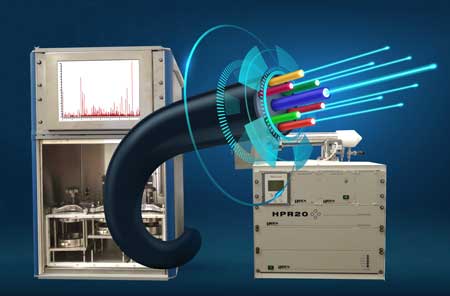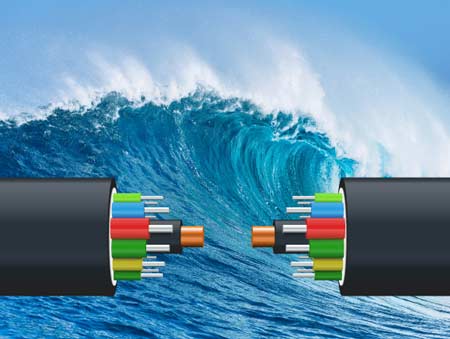

Vapour permeability is a critical factor in the production and operation of optoelectronic devices and fibres, significantly impacting their longevity, performance, and reliability. Optoelectronics, which cover technologies such as LEDs, solar cells, and photodetectors, alongside the optical fibres used in telecommunications and sensing applications, are particularly sensitive to environmental influences, including moisture.
 The permeation of moisture leads to the degradation of these components, causing serious performance issues or even device failure. This is especially relevant for optoelectronic equipment that contains sensitive elements such as semiconductors, displays and sensors, which require robust protection against corrosion and other forms of moisture-induced damage. Materials with low vapour permeability serve as essential barriers, safeguarding these devices, particularly in outdoor applications like solar panels, LED streetlights, and fibre-optic cables, where varying weather conditions could otherwise compromise their functionality.
The permeation of moisture leads to the degradation of these components, causing serious performance issues or even device failure. This is especially relevant for optoelectronic equipment that contains sensitive elements such as semiconductors, displays and sensors, which require robust protection against corrosion and other forms of moisture-induced damage. Materials with low vapour permeability serve as essential barriers, safeguarding these devices, particularly in outdoor applications like solar panels, LED streetlights, and fibre-optic cables, where varying weather conditions could otherwise compromise their functionality.
In the packaging and encapsulation of optoelectronic devices, such as OLED displays or photovoltaic cells, materials must exhibit very low vapour permeability to shield internal components from moisture and oxygen. The use of advanced materials, including thin-film encapsulation and barrier coatings, is prevalent to reduce permeability. Devices like OLEDs and organic solar cells are particularly vulnerable to moisture and oxygen, as these gases can rapidly degrade the organic layers in their structure, significantly shortening their lifespan and reducing their efficiency. Therefore, high-performance coatings with low vapour permeability have become crucial in extending the operational life of these devices.
In the realm of fibre optics, vapour permeability control is of paramount importance, particularly for cables used in telecommunications under challenging conditions like outdoor installations or underwater environments. The penetration of moisture into the cable's protective cladding can lead to signal loss, optical degradation, and cable failure. To mitigate this, materials with high vapour permeability resistance are employed in the cladding or protective sheathing, ensuring that optical performance remains stable and the system's lifespan is extended. This is especially vital for high-bandwidth communication networks and undersea cables, where repairs can be difficult and costly.
Flexible optoelectronics, such as wearable electronics,  flexible displays, and sensors, also require careful management of vapour permeability. These devices are exposed to environmental factors, such as moisture, heat and mechanical stresses. Flexible polymers and substrates used in their construction must control vapour permeability to prevent moisture damage while retaining flexibility. In wearable electronics or flexible displays, a delicate balance is necessary, some degree of vapour permeability is beneficial to avoid condensation inside the device, but too much could allow access to damaging moisture. This balance is essential for maintaining device performance and longevity across different environmental conditions.
flexible displays, and sensors, also require careful management of vapour permeability. These devices are exposed to environmental factors, such as moisture, heat and mechanical stresses. Flexible polymers and substrates used in their construction must control vapour permeability to prevent moisture damage while retaining flexibility. In wearable electronics or flexible displays, a delicate balance is necessary, some degree of vapour permeability is beneficial to avoid condensation inside the device, but too much could allow access to damaging moisture. This balance is essential for maintaining device performance and longevity across different environmental conditions.
Photovoltaic systems, particularly thin-film and organic solar cells, are highly susceptible to moisture. Water vapour can penetrate the layers of the solar cells, causing problems of delamination, oxidation, or corrosion of crucial materials. Therefore, materials with high-performance barrier properties and low vapour permeability are vital for preventing these issues. In outdoor solar installations, the protective layers must guarantee that solar cells maintain can their efficiency over extended periods. This reduces maintenance costs and enhances energy output.
Optoelectronic sensors, such as photodetectors and environmental monitoring sensors, often operate in environments where humidity or condensation is present. Moisture infiltration into these sensors compromises sensitivity and accuracy, both are vital in applications like medical diagnostics, industrial automation and environmental monitoring. By using materials that carefully control vapour permeability, it is possible to protect these sensors from moisture-induced failures, ensuring consistent performance and reducing the risk of calibration drift.
Thermal management in some optoelectronic applications may involve materials with selective vapour permeability to help regulate moisture and prevent condensation that accumulates when devices heat up during operation. Allowing moisture vapour to escape helps prevent thermal stress or short-circuits, however it is essential to strike the right balance, as excessive permeability could allow environmental moisture to infiltrate the device. This balance is crucial for high-power optoelectronics like lasers and LED modules, where managing heat and moisture is integral to the device's performance.
 For optoelectronic equipment in harsh environments, such as aerospace, automotive, or industrial applications, the use of materials with ultra-low vapour permeability is essential to protect against high humidity, rain, or even submersion. Devices used in these settings, like LED automotive lighting or space-based optoelectronics, must be designed to withstand extreme conditions. Protective materials that effectively limit vapour permeability ensure that the devices continue to function reliably over long periods, despite being exposed to challenging conditions.
For optoelectronic equipment in harsh environments, such as aerospace, automotive, or industrial applications, the use of materials with ultra-low vapour permeability is essential to protect against high humidity, rain, or even submersion. Devices used in these settings, like LED automotive lighting or space-based optoelectronics, must be designed to withstand extreme conditions. Protective materials that effectively limit vapour permeability ensure that the devices continue to function reliably over long periods, despite being exposed to challenging conditions.
Managing vapour permeability is a fundamental aspect of materials design in optoelectronics and fibres, with far-reaching implications for device durability, the protection of sensitive components, and the maintenance of reliable performance. Whether it involves shielding electronics from moisture damage, preserving the integrity of fibre-optic cables, or enhancing the resilience of wearable devices, striking the right balance between breathability and impermeability is the key to preventing moisture-related degradation and ensuring optimal functionality even across demanding environments.
Click here for a detailed optoelectronics application
Click here for a press release